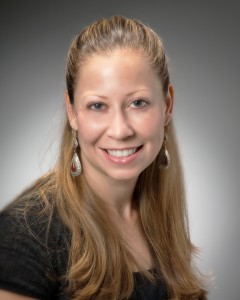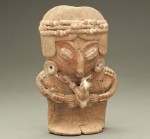The original version of this article contained an error and has been changed. See the bottom of the article for additional information.
Victoria Lyall, the Associate Curator of Art of the Ancient Americas at the Los Angeles County Museum of Art, returns to her alma mater to speak in a gallery talk on the Fowler Museum at UCLA’s Chupícuaro ceramics today at noon.
UCLA boasts one of the most comprehensive collections in the United States of these ancient Mesoamerican art pieces, as donated by actress Natalie Wood from 1968-1969. Select pieces were put on display as part of the “Fowler at Fifty” exhibitions, curated by Lyall herself. The latest “Culture Fix” event will feature Lyall speaking on new research about the Chupícuaro ceramics. Lyall spoke with the Daily Bruin’s Natalie Green about the background of the art pieces and her personal connection with them.
Daily Bruin: Can you tell us a little bit about how Chupícuaro ceramics were discovered?
Victoria Lyall: The region itself, Chupícuaro, is located in the state of Guanajuato, which is actually north-central Mexico. (It can be considered) sort of as a frontier, a nexus point between two cultural zones. The way that the ceramics actually came to be known was through looting. They started popping up on the art market, and … they’re quite unique. They have very bold colors, especially when you consider the time frame that they were produced in: somewhere around 400 B.C.E. The palate is mostly primary – reds, blacks and whites. There are geometric decorations and lots of chevron patterns or netting. They’re very big, bold forms and quite attractive.
DB: What is the historical background or significance behind Chupícuaro ceramics?
VL: In the 1920s, the Mexican archaeological commission had already been formed and they started seeing these (pieces) and they were like, “Wait, we don’t know what this belongs to. We have to check this out.” So they started talking to the dealers and were informed that all of these extraordinary objects were coming from this one area … they found an acropolis, sort of a burial ground, and that’s where they found a lot of the pots. Unfortunately, about a year after the excavations were done, they built a huge dam that flooded the valley, so the actual archaeological site of Chupícuaro is underwater. Because of that, they really haven’t been looked at again until recently.
DB: After the site was flooded, what sparked the more recent research on the ceramics?
VL: In the late ’80s and early ’90s, a couple of different teams started to look at the site. And the reason that it reignited interest is that it gives us this idea of very early population. This is the first urban settlement in Mesoamerica, and Chupícuaro shows us in a very interesting way all of their stories and influences that come from the north, the southwest and from the south and central valley. What happened is when Chupícuaro fades, the great big urban metropolis upsurges. So you see a little bit of the ebb and flow of civilization (through this art).
DB: How did you personally get involved with art of the ancient Americas, specifically Mesoamerican?
VL: I’m a Bruin, I received my doctorate at UCLA and studied pre-Columbian art. I studied it in undergrad. I (also) did art history and anthropology, and I just was really interested in it. When I was graduating, I didn’t know what I was going to do, and I was lucky enough to get a fellowship to do some research at the Metropolitan Museum of Art. They said, “Here, we have this collection of Mayan material, will you look at it?” So that’s what I did. And I kind of fell in love … What fascinates me about art in particular is the way we use the images to communicate. A lot of these cultures, especially so early, have not left us a written record but they have left us a visual record. And we can tease out some of their identity and some of their cultural beliefs by deciphering these visual records.
 [media-credit name=”Daily Brui” align=”alignright” width=”240″]
[media-credit name=”Daily Brui” align=”alignright” width=”240″]
DB: Can you discuss the new research revealed on the Chupícuaro ceramics that will be further explored in your gallery talk?
VL: One of the things that has been reevaluated is that most of the ways that we assign chronology in time is through ceramics. When you don’t have carbon-14 dating and good skeletal remains, you look at the ceramics and you cerate them. You try to put them in order from earliest to latest. And (when) they did that for Chupícuaro, they established clear periods. Recently those have been reanalyzed. This French team has been (looking) at the patterns of the settlement immediately outside of the Chupícuaro zone, (where) they can see some similarities between the shapes of the ceramics and the shapes of the plazas and urban settlements. (Similarities in the ceramics) give us some sense that there was trade happening all the way down to South America.
DB: How do you think the Chupícuaro ceramics exhibition is relevant to today’s students?
VL: The most important thing I think about an installation, and any exhibition – it doesn’t matter if it’s ancient Americas or contemporary or whatever – is to get the audience to understand that objects work in dialogue with one another, so that when you walk into the space, without reading my text, without reading the labels, you should be able to have some kind of reaction or connection to the objects. And if there are similarities or differences as you walk through the space, you should be able to have an “Aha” moment for yourself. I think it’s relevant to students because we’re doing that all the time when we walk through everyday life. We’re a very image-based society but we still have to learn those sorts of tricks to decoding images.
Correction: The Fowler Museum’s full name is the Fowler Museum at UCLA.

This is a comment about the transcription of the interview.
Into the Vicoria Lyall’s answer to the second question is written “they found an acropolis”, but she more likely said “they found a necropolis”, which is actually closer to archaeological record.